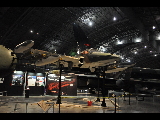|
Cessna YA-37A (62-5951) Dragonfly Walk Around Page 2

Any questions, comments, or problems, please
email me.
These pictures were taken and shared with the web by
Weichao Chen
.
In the early 1960s, the Air Force investigated the conversion of the Cessna T-37 jet-powered primary trainer for counterinsurgency missions. The project was intended to provide an inexpensive aircraft for the U.S. export market. In 1962 two T-37Bs (S/N 62-5950 and 62-5951) were modified and tested at Eglin Air Force Base, Fla. The aircraft retained the T-37's Continental J69 engines, but since gross weight increased to accommodate the ordnance and attack avionics, the aircraft was underpowered and performed poorly.
In 1963 the USAF updated the requirement and reissued a contract for two improved aircraft and assigned them the YAT-37D designation. In order to meet contract delivery dates, Cessna used the two original YAT-37 prototypes for the updated program. Several major changes were incorporated into the design, including new engines. The J69 jet engines were replaced by General Electric J85 turbojets of 2,400 pound thrust, more than double the thrust of the J69s. The wings were strengthened for six ordnance (three per wing) hardpoints and the wingtips were fitted with 95 gallon fuel tanks. Self-sealing fuel tanks were put in the wings and armor plating was installed to protect the pilot. The YAT-37D was upgraded with various avionics upgrades including a target acquisition system. A General Electric GAU-2/A 7.62mm mini-gun with a 1,500-round capacity was mounted in the forward left nose section. A radar ranging gun site for the pilot and a gun camera complemented the GAU-2/A Gatling gun. The YAT-37D's first flight was on Oct. 22, 1963. After testing was completed, the YAT-37Ds were unneeded, and the first prototype was sent to the National Museum of the United States Air Force in December 1964.
In August 1966, the YAT-37D at the museum was recalled for additional flight testing. The war in Vietnam highlighted a need for a Close Air Support/Counterinsurgency to complement and possibly replace the Douglas A-1 Skyraider. The aircraft was modified with an additional hardpoint on each wing and redesignated YA-37A. The test program was successful and the USAF ordered the conversion of 39 T-37s to the YA-37A standard for immediate combat testing in Vietnam. These aircraft were designated A-37As.
The YA-37A was permanently retired to the National Museum of the United States Air Force in July 1970 and remains on display.
Located at the National Museum of the Air Force, Wright Patterson AFB, OH.


|